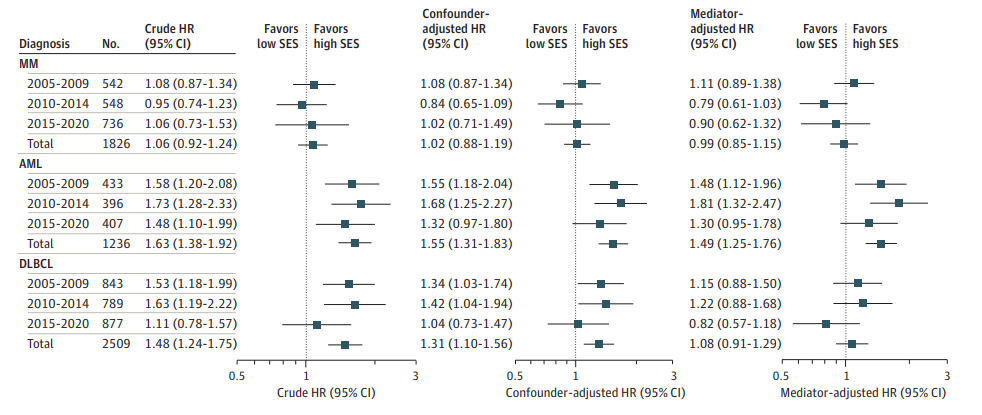
Introduction
Research typically measures socioeconomic status (SES) through education level or income. This status significantly influences the course and outcome of cancer cases. In countries with tax-funded healthcare systems, disparities in outcomes linked to non-biological factors like SES could suggest unintentional roadblocks in healthcare access. A recent study aimed to shed light on survival differences across SES groups for three aggressive haematological malignant neoplasms in Denmark.
Impact of Socioeconomic Status on Cancer Survival Rates
Patients with low SES may have poorer results due to many variables. Possible variables include delayed diagnosis, low screening participation, poor treatment adherence, lesser intensity, and lowered trial participation, comorbidities, and unhealthy lifestyle. A 2022 meta-analysis investigated SES inequality in Nordic cancer, revealing inequalities in diagnosis, treatment, and survival rates. Over time, survival rates have improved overall. But new medicines, however, only help those with high SES, indicating growing social inequality in cancer treatment.
Denmark’s study focused on three aggressive haematological malignant neoplasms: multiple myeloma (MM), acute myeloid leukaemia (AML), and diffuse large B-cell lymphoma (DLBCL). Researchers analysed patients aged 25 to 65 years. They stratified the analyses by calendar year to track evolving differences. The study divided the analyses into groups based on diagnosis time. They set the time intervals as 2005 to 2009, 2010 to 2014, and 2015 to 2020.
Survival Rates by Socioeconomic Status
The study found no significant difference between the low and high SES groups for patients with MM across the three periods. However, for AML, significant differences were found in all three periods. For DLBCL, significant differences were found for 2005 to 2009 and 2010 to 2014, but no significant difference was seen in the 2015 to 2020 period.

*P values are from log-rank tests. The vertical line indicates censoring. Shaded areas indicate 95% CIs.
Discussion
The study found improvements in overall survival for all three diseases during the study period. For patients diagnosed with MM, they found no significant differences in outcome associated with SES. For patients with DLBCL and high SES, they observed better outcomes in the two earlier periods. However, this difference was reduced in recent years and disappeared after adjusting for mediators. For AML, they found a significant association of SES with outcome throughout the study period, favouring patients with high SES.

*Hazard ratios are estimated using patients with high socioeconomic status (SES) as reference. The confounder-adjusted model includes age and sex, and the mediator-adjusted model includes age, sex, performance score, comorbidity, and disease-specific prognostic index.
Conclusion
In conclusion, this comprehensive analysis provides valuable insights into the link between socioeconomic status and survival rates among patients with haematological malignant neoplasms. The lessons learned from countries like Sweden and USA underscore the importance of addressing social inequalities that may inadvertently create barriers to healthcare access. Clearly, not only biological factors determine survival rates, but socioeconomic variables also play a significant role. This calls for a more holistic approach in healthcare provision, one that considers the socioeconomic realities of patients and strives to deliver equal access to healthcare services.
